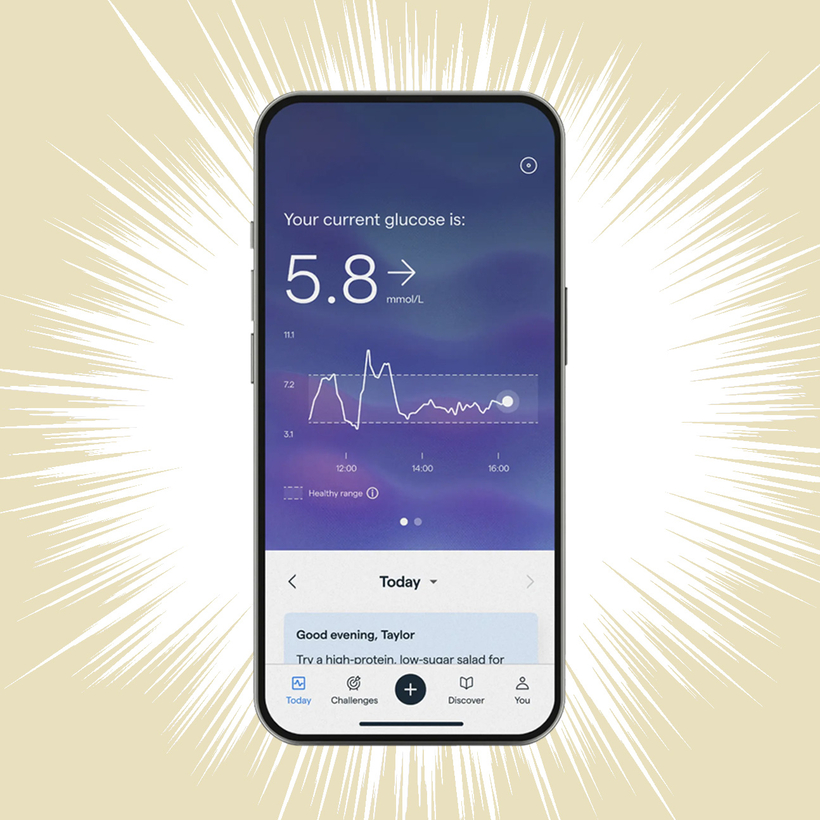The Lingo Biosensor
Keep your blood sugar from going haywire with this discreet monitor
Monitoring your blood sugar with a view to managing glucose spikes and sudden drops is the newest trend in the ever growing field of the “quantified self.”
Wearing a Bluetooth blood-sugar monitor was previously something a doctor would prescribe if you were pre-diabetic or diabetic. But a few health-care companies have lately been releasing consumer constant glucose monitors (C.G.M.’s) for those of us without diabetes who nevertheless feel we suffer a roller coaster of energy peaks and slumps through the day, and that this could be related to certain foods.
Depending on which doctor or nutritionist you speak with, a couple of weeks with a C.G.M. is either a fine idea for researching which foods you should avoid to achieve peak performance—or an egregious example of the “worried well,” well, worrying.
My neurologist neighbor came for coffee in our garden last weekend and spotted on my upper arm the extensively advertised new Abbott Lingo device I have been trialing. “I didn’t know you were diabetic,” she said. I explained that I’m not but am just intrigued by the technology and finding it quite helpful, as I’m prone to a slump after anything carb-heavy.
I then showed her how quickly the Lingo app (for iPhone only) reacted when I ate a cookie. She looked skeptical. “Do you really need a device to tell you a cookie will give you a glucose spike?”
Yes, actually. Seeing it demonstrated has been interesting and instructive—and it has also helped me avoid taking resultant afternoon naps, which are very enjoyable but waste an hour or so of the working day.
Additionally, I’ve found it kind of gamifies eating better in a way no other technology has. It will appeal, possibly, to any mechanically minded driver who watches the rev counter as often as the speedometer. Not everyone’s idea of fun, I acknowledge, but it works for me.
In two weeks, I’ve seen clearly how a small lunchtime portion of the very British dessert bread-and-butter pudding (which is a lot better than it sounds) at our local London pub sent my glucose into orbit and took 90 minutes to sleep off.
On the other hand, a hard-boiled egg sent my glucose down from a healthy 6.3 millimoles per liter to an even healthier 5.9.
I was taken to a Michelin-starred London restaurant for their tasting menu, with a carefully selected wine for each course, and even though I had a lot to drink and eat, my glucose stayed steadily within healthy limits. What I didn’t know was that alcohol apparently lowers blood sugar, which sounds to me like rather good news.
Another surprise was that the highest spike I experienced was not caused by food at all but by a rather intense discussion—O.K., a fight—with my partner. Stress, it seems, boosts sugar.
I’ve loved using Lingo, although others have complained that the sensor is uncomfortable after a few days. I have barely noticed it, which led to an alarm during the first shower I took with it on—Lingo is fully waterproof—when I momentarily thought I’d sprouted a giant wart overnight.
A point one friend made was that someone prone to eating disorders could find the device and its instant insights triggering. Noted.
It seems that Abbott, an enormous and reputable company, has been able, ethically, to offer Lingo to those who perhaps don’t strictly need it by specifying that it’s “not a medical device.” But it’s hard to see what else it is. It’s definitely not a toy, and probably a lot more than a novelty or fad.
Generic Waist-Level Viewfinder

Shoot from the hip, like your favorite street photographers
There’s a lot to be said for buying cheap but excellent Chinese gadgetry while stocks last.
I bought this $23 waist-level viewfinder because, in the age of the smartphone camera, when everyone is a potential Cartier-Bresson, taking good street-reportage-type photos is really difficult.
I noticed this the other week, when testing the fabulous but not very discrete Fujifilm GFX100RF. At best, people going about their day in public places shy away when you obviously are photographing them. At worst, they get quite aggressive.
In the past, photographers such as the sublime Vivian Maier managed candid photography using a Rolleiflex or similar twin-lens reflex, where you look down to the viewfinder and appear less like a photographer and more like someone adjusting a surveying device. (There are cheap imitations of these 1950s machines around, but they seem pretty nasty.)
Using a clip-on waist-level viewfinder, however, like my generic $23 purchase, means you can shoot with reasonable accuracy with anything from a serious modern camera to a classic 35-mm., like my wonderful Nikon FM2. Subjects mostly don’t pose or notice the camera. You get an interesting angle, closer to how a child might see the world. And you get a level of imperfection and spontaneity that looks vital and active.
Many great photographers, like Joel Meyerowitz and Garry Winogrand, perfected the art of shooting from the hip, but trying it afresh, you’ll miss a lot of shots. Any one of about 100 identical, Chinese-made waist-level viewfinders, all offered at different prices on Amazon, will make it a great deal easier.
Separately, here’s a tip for when you spot the street photo of a lifetime and don’t have your camera: if you pretend you’re texting or even FaceTiming a friend on your cell phone, you can actually point the smartphone camera straight at your target, without alarming them, and snap away.
The Volantex R.C. Airplane

Play out your dogfight fantasies with a radio-controlled aircraft
In these turbulent times, retreating to the simple comfort of old hobbies, or pursuing childhood pastimes with an adult budget, may be one of the best ways of temporarily forgetting that T***p, P***n, and the rest exist.
One national-magazine editor I know well—and who has sworn me to secrecy—has reverted, while figuring out what headlines to write on work-from-home days in his upstate New York basement, to painting miniature military figures. He hasn’t done this since he was 14.
My way of achieving amnesia, albeit fleetingly, has been by flying an amazingly sophisticated and well-priced, ready-to-fly radio-controlled aircraft from—again—China.
I chose, being British, a Spitfire, but there are plenty of American models made by the excellent VolantexRC, available pretty cheaply (for now) on Amazon.
They have several models expressly for rookie pilots and, so long as the wind is low, they are very easy to fly. There’s even an aerobatics button on the controller to pull off flying feats. I’ve always liked to think of flying model aircraft as a modern update on kite flying for spiritual renewal. The ancient Chinese were big on kites as a way of “liberating the soul.”
Many R.C. pilots write online about the emotional and meditative aspect of flying and the sensation of “becoming the plane”—detaching from the body and feeling almost as if you’re soaring with the aircraft.
This may be why, according to the Internet, Tom Hanks, Harrison Ford, Eric Clapton, and Mike Oldfield—the Tubular Bells man—are among well-known people who have at some point confessed to liking R.C. models.
The Cloudflare WARP 1.1.1.1 App

A new Internet protocol that makes browsing faster and more private
Here is an unusual tech recommendation, in that I have no way of assessing whether it does what it’s supposed to, but it comes so highly acclaimed that it must.
Cloudflare is a 16-year-old company in San Francisco making security software, mostly for big corporations and governments around the world. They now also have a free offering for private users called WARP 1.1.1.1, which claims to make the Internet faster and safer on Macs, P.C.’s, and all smartphones.
The person who told me it’s essential and safe is a young I.T. manager for a TV channel who is on top of all the tech trends and is reliable.
All I can say is that it’s incredibly easy to install and runs without fuss. If you need to use a V.P.N. for any reason, you can click WARP off and on again. WARP is not a V.P.N., but it clashes with my excellent ExpressVPN and probably others.
Cloudflare sounds like an interesting outfit. For most of the past decade, it has generated the random data it needs for encryption keys by taking photos of a wall of lava lamps, a set of double pendulums, and a Geiger counter.
Based in London and New York, AIR MAIL’s tech columnist, Jonathan Margolis, spent more than two decades as a technology writer at the Financial Times. He is also the author of A Brief History of Tomorrow, a book on the history of futurology


